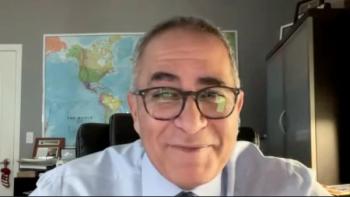
Duration of Therapy in NDMM
Before closing their discussion on transplant-eligible, newly diagnosed multiple myeloma, experts consider duration of therapy in this setting.
Episodes in this series

Transcript:
Noopur Raje, MD: Andrew, one other question, and I think Jacob highlighted this a bit. Talking about for most patients on the GRIFFIN trial, you’re continuing the lenalidomide with the daratumumab, and you drop the proteasome inhibitor unless they have high-risk disease, is that right, or for everybody?
Jacob Laubach, MD, MPP: No, it was either lenalidomide, or lenalidomide and daratumumab.
Noopur Raje, MD: Perfect, you drop it in everybody. In terms of duration of that maintenance, do we have a sense of how long to treat? I know we use lenalidomide forever, up until progression, that is the American way of doing maintenance. With daratumumab, there are ongoing trials looking at the role of maintenance. But if you extrapolate the GRIFFIN data, how long in practice would you continue the daratumumab?
Andrew J. Yee, MD: I think that’s a question we all struggle with because clinical practice and clinical trial data, they’re all moving together so quickly. The data from GRIFFIN are fantastic, and quickly became adopted across various practices. But if you wanted to be true to the GRIFFIN data, the daratumumab was up to cycle 32, and then it became lenalidomide maintenance. At the same time, and we’ll probably touch on this later, but in the MAIA study, which was in transplant-ineligible patients, the daratumumab was continued long term. There wasn’t a fixed duration of daratumumab. There was also the CASSIOPEIA study, but that’s a separate question. There are 2 schools of thought; I guess there’s always different ways of looking at this. I think daratumumab, it’s well tolerated; I don’t have any patients complain about being on daratumumab, aside from coming in for the visits for the drug, which I understand that there’s a burden. From an adverse effect profile, patients for the most part tolerate it well. I appreciate though that long term, we don’t know what it means to be on daratumumab. That’s something that’s becoming appreciated in this COVID-19 era, the risk of infection. I don’t think we talk about it as much, that daratumumab, yes, there is more risk of infection and more hypogammaglobulinemia. That’s something to pay attention to. I’m just trying to present a balanced view of this, which is challenging.
Noopur Raje, MD: I agree with you. I don’t think we have great data on how long to treat with daratumumab based on the GRIFFIN data, which Jacob so nicely presented, doing it up to 32 cycles. I think what you said, Andrew, is true. The risk of infections is underappreciated, and as we are all living through a pandemic, this is something that should be front and center. We all know that patients who are on a monoclonal antibody directed against CD38 have antibody responses to vaccination, etc, that are a lot lower. Having said that, I think most of us would do up to 32 months based on your data, and we will await more of the maintenance trial.
Transcript edited for clarity.
Newsletter
Stay up to date on recent advances in the multidisciplinary approach to cancer.


















































































